
Korean Confucianism is the form of Confucianism that emerged and developed in Korea. One of the most substantial influences in Korean intellectual history was the introduction of Confucian thought as part of the cultural influence from China.

Neo-Confucianism is a moral, ethical, and metaphysical Chinese philosophy influenced by Confucianism, which originated with Han Yu (768–824) and Li Ao (772–841) in the Tang dynasty, and became prominent during the Song and Ming dynasties under the formulations of Zhu Xi (1130–1200). After the Mongol conquest of China in the thirteenth century, Chinese scholars and officials restored and preserved neo-Confucianism as a way to safeguard the cultural heritage of China.

Yi Hwang was a Korean philosopher, writer, and Confucian scholar of the Joseon period. He is considered the most important philosopher of Korea - he is honored by printing his portrait on the 1000 Won banknote, on the reverse of which one can see an image of his school, Dosan Seowon. He was of the Neo-Confucian literati, established the Yeongnam School and set up the Dosan Seowon, a private Confucian academy.

Korean court music comprises three main musical genres: aak, an imported form of Chinese ritual music; a pure Korean form called hyangak; and a combination of Chinese and Korean styles called dangak.
AakKorean pronunciation:[a.ak] is a genre of Korean court music. It is an imported form of the Chinese court music yayue, and means "elegant music". Aak was performed almost exclusively in state sacrificial rites, and in the present day it is performed in certain Confucian ceremonies.
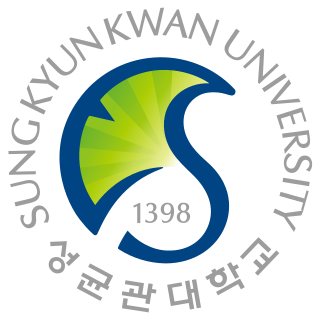
Sungkyunkwan University is a private research university with campuses in Seoul and Suwon, South Korea.
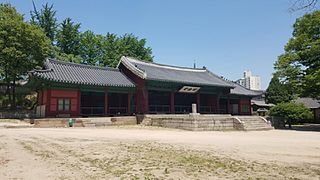
Sungkyunkwan (Korean: 성균관) was the foremost educational institution in Korea during the late Goryeo and Joseon Dynasties. Today, it sits in its original location, at the south end of the Humanities and Social Sciences Campus of Sungkyunkwan University in Seoul, South Korea. Twice a year, in May and September, the ceremonial rite Seokjeon Daeje is performed in the Munmyo Shrine, to honor Confucius and the Confucian sages of China and Korea.
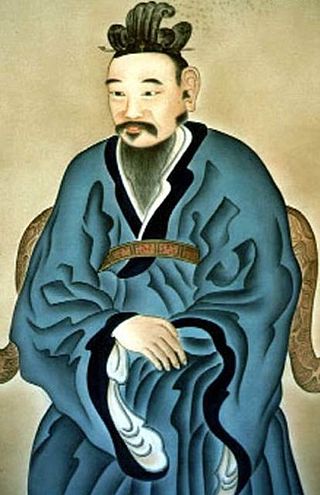
Ch'oe Ch'i-wŏn was a Korean philosopher and poet of the late medieval Unified Silla period (668-935). He studied for many years in Tang China, passed the Tang imperial examination, and rose to the high office there before returning to Silla, where he made ultimately futile attempts to reform the governmental apparatus of a declining Silla state.
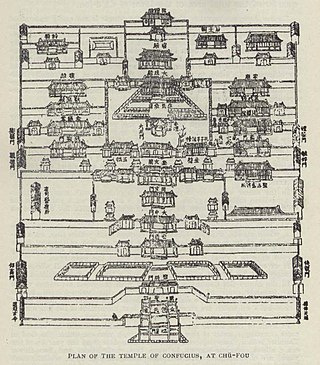
A temple of Confucius or Confucian temple is a temple for the veneration of Confucius and the sages and philosophers of Confucianism in Chinese folk religion and other East Asian religions. They were formerly the site of the administration of the imperial examination in China, Korea, Japan and Vietnam and often housed schools and other studying facilities.

The hun is a Korean Xun-like globular flute made of baked clay or other ceramics.

Jo Gwang-jo, also often called by his art name Jeongam (정암), was a Korean Neo-Confucian scholar who pursued radical reforms during the reign of Jungjong of Joseon in the early 16th century.

Jongmyo (Korean: 종묘) is a Confucian royal ancestral shrine in the Jongno District of Seoul, South Korea. It was originally built during the Joseon period (1392–1897) for memorial services for deceased kings and queens. According to UNESCO, the shrine is the oldest royal Confucian shrine preserved and the ritual ceremonies continue a tradition established in the 14th century. Such shrines existed during the Three Kingdoms of Korea period (57–668), but these have not survived. The Jongmyo Shrine was added to the UNESCO World Heritage list in 1995.

Traditional Korean musical instruments comprise a wide range of string, wind, and percussion instruments. Many traditional Korean musical instruments derive from Chinese musical instruments.

The National Gugak Center (Korean: 국립국악원), located in Seoul, South Korea, is the primary institution of learning for Korean traditional music, including both court music and folk music. It was founded in 1951 through a merger of Korean musical organizations.
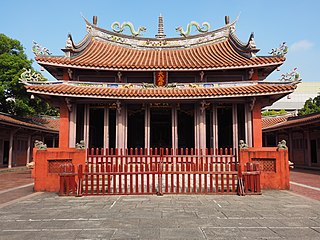
The Tainan Confucian Temple or Quan Tai Shou Xue, is a Confucian temple on Nanmen Road (南門路) in West Central District, Tainan, Taiwan.

Chinese temple architecture refer to a type of structures used as place of worship of Chinese Buddhism, Taoism, Confucianism, or Chinese folk religion, where people revere ethnic Chinese gods and ancestors. They can be classified as:
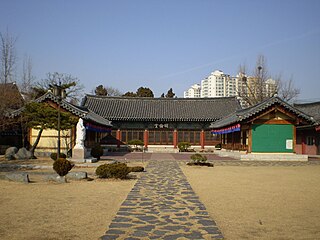
The Daegu Hyanggyo (Korean: 대구향교) is a hyanggyo in Daegu, South Korea. A hyanggyo is a state-sponsored academy where students studied to prepare for the gwageo, the civil service examinations during the Goryeo (918–1392) and Joseon (1392–1910) periods. This hyanggyo was founded in 1398 during the reign of King Taejo of Joseon.

Ha Ryun, also spelled as Ha Yun (Korean: 하윤), was a Joseon politician and Neo-Confucian scholar, educator, and writer. He served as Chief State Councillor during the reign of King Taejong from 1408 to 1409, from 1409 to 1412 and again from 1414 to 1415. He was from the Jinju Ha clan.

The Seokjeon Daeje (Korean: 석전대제), also sometimes called Seokjeonje, is a ceremonial rite performed twice annually to honor Confucius. It is held at Confucian sites across South Korea including hyanggyos and the Confucian temple Munmyo located at Sungkyunkwan, on Confucius' birthday in fall and the anniversary of his death in spring. Seokjeon is made up of the two Chinese characters, 釋 and 奠 (alcohol), and Seokjeon Daeje means "Laying out offerings ceremony". It involves an elaborate ceremony with sacrificial offerings of alcohol and foods, as well as an elaborate dance known as munmyo ilmu accompanied by musical performances munmyo jeryeak.

Myo is a Korean term for Confucian shrines, where the ritual jesa is held. While this concept is nowadays mainly known for the Joseon dynasty's Jongmyo shrine in Seoul, its history dates back to the Three Kingdoms period.





















